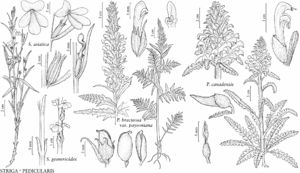Striga asiatica
Revis. Gen. Pl. 2: 466. 1891.
Annuals 15–35 cm; hemiparasitic. Taproots slender, not fleshy; secondary-roots present; haustoria multiple, small, globular. Flowering-stems drying green, simple or branched medially, obtusely square, not fleshy, antrorsely scabrous-hispid. Leaves: basal blade opposite, lanceolate scales, midstem blade alternate, ascending or spreading, linear or narrowly elliptic, 20–50 x 2–4 mm, surfaces scabrous-hispid. Inflorescences racemes, lax; flowers alternate; bracts linear, 20–35 x 1–2 mm, longer than calyx, surfaces hispid. Flowers: sepals 5 (–8), 7–8 mm; calyx: tube 5 mm, ribs 10, hispid, teeth 5 and equal or 6–8 and subequal, lanceolate or sublanceolate, 2–3 mm; corolla red, rarely yellow, throat yellow, glandular-pubescent, tube bent, expanded distally, 15 mm, abaxial lobes 12 mm wide, adaxial 5 mm wide; style 7–10 mm, rolled in when dry, sparsely hairy or glabrous. Capsules oblong, 5–7 x 2–3 mm. 2n = 24, 40 (Nigeria).
Phenology: Flowering Jul–Aug.
Habitat: chiefly in maize fields.
Elevation: 20–90 m.
Distribution
Introduced; N.C., S.C., Africa
Discussion
Striga asiatica was discovered in southern North Carolina and adjacent South Carolina in 1956 (H. R. Garriss and J. C. Wells 1956). At one time, 38 counties in the Carolinas were infested (R. E. Eplee 1981). Through a comprehensive control program and quarantine measures, the original infested area has been reduced by 99%, with only about 2135 acres remaining in 2009 in five counties (Bladen, Cumberland, Pender, Robeson, and Sampson) in North Carolina and no acres infested in South Carolina (R. Iverson et al. 2011). Additional information on S. asiatica, maps of infected areas, and the eradication program in the Carolinas can be found in Iverson et al. The authors treat S. asiatica in the narrow sense; reports of S. asiatica from southern Asia require further study. They may refer to S. lutea Loureiro or S. hirsuta Bentham, species included by some (http://www.cabi.org/isc/datasheet/51786) in S. asiatica.
Use of the name Striga lutea by C. J. Saldanha (1963) and C. E. Smith (1966) for plants in the flora area is a misapplication. Saldanha rejected S. asiatica, believing that its Linnaean basionym could not be lectotypified; see F. N. Hepper (1974) for a counterargument and lectotypification.
Studies on climatic requirements and potential for spread indicate that Striga asiatica could invade new areas as a result of global warming (D. T. Patterson et al. 1982; K. I. Mohamed et al. 2006, 2007).
Selected References
None.
